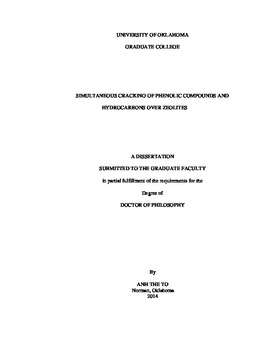| dc.description.abstract | Co-processing bio-oils with hydrocarbons in conventional refinery processes has been considered as a promising strategy for upgrading and producing fuels from alternative sources. Co-feeding the phenolic fraction to the Fluid Catalytic Cracking (FCC) unit is an attractive but challenging pathway. Even though the high capacity and flexibility of the FCC process can boost the usage of bio-fuels in large scale, the strong adsorption and coke formation from the phenolic compounds might have a negative impact on the catalytic cracking of hydrocarbons. Therefore, in this research, we have conducted fundamental studies of the reaction of hydrocarbons, phenolic compounds, and their mixtures over zeolites under similar conditions to catalytic cracking process to understand the effect of the phenolic compounds on the reaction of hydrocarbons. The study has been carried out mainly using a micropulse reaction system in order to explore the reactivity of fresh catalysts.
The catalytic activity of HY zeolite is enhanced upon high temperature pretreatment due to the generation and synergism of the Lewis acid species with the original Brønsted acid sites to form a new type of site (synergistic site) that displays enhanced activity for both protolytic cracking and dehydrogenation reactions of paraffins. The activity enhancement caused by the synergistic sites is clearly evident for the monomolecular protolytic reaction, but it is not apparent in the conversion of olefins. Even though the synergistic sites were deactivated very quickly by strong adsorption of hydrocarbon species, they could be regenerated by a subsequent high temperature treatment. Furthermore, the preference for reaction pathways depends on the activation entropy of the transition state for each path. With n-hexane feed, the enhancement of dehydrogenation is greater than for protolytic cracking, but the opposite trend was observed in the conversion of 2,3-dimethylbutane. The contributions of different reaction pathways of paraffins also depend on the reaction parameters. Monomolecular reaction is more favored at high reaction temperature, at low paraffin concentration, and at low conversion, where olefinic product’s concentration is low; while bimolecular hydride transfer reaction is more favorable at high reaction temperatures with high paraffin and olefinic product concentrations. Also, branched paraffins with tertiary carbons are also better hydride donors than linear ones.
In the conversion of pure phenolic compounds (i.e. m-cresol and anisole), the zeolites capture the phenolic compounds significantly via molecular adsorption and condensation reactions forming oligomeric phenolic species (i.e. phenolic pools), which are still active for reaction at higher temperature to produce aromatics and light hydrocarbons. With increased reaction temperature, along with enhanced cracking to aromatics, the phenolic products were also captured to a less extent, which resulted in less carbonaceous deposition. The zeolite structure also has a strong effect on the formation and decomposition of the phenolic pool. For instance, small pore zeolite (i.e. HZSM-5) appears to be a better catalyst than HY in term of aromatic production, coke formation and catalyst stability.
Due to strong adsorption and coke formation tendency, co-feeding small amounts of m-cresol caused severe deactivation to the synergistic sites, and slightly deactivated the reaction at normal Brønsted acid sites due to competitive adsorption at low reactant concentrations. Interestingly, when the reactant concentration was increased or a better hydride donor reactant was used, the deactivation effect of m-cresol diminished. Enhanced hydride transfer from the paraffin at higher reactant concentrations promoted desorption of the phenolic compounds and reduced coke formation leading to less deactivation. Co-feeding m-cresol also affected the contribution of different reaction pathways of paraffins. Competitive adsorption deactivated protolytic cracking and protolytic dehydrogenation paths. In addition, the phenolic pool, formed by condensation of phenolic compounds, acted as a hydride acceptor and competed with hydride transfer between hydrocarbons. In reverse, hydride transfer from hydrocarbons also promoted desorption of the phenolic compounds, suppressed the formation of the phenolic pool which resulted in less aromatics and coke formation.
The positive effect of hydride transfer towards catalyst deactivation was confirmed in the reaction of anisole with tetralin, a good hydride donor agent. In anisole conversion, catalyst deactivation is significant due to strong adsorption of phenolic compounds and coke formation. The latter is an irreversible process, whereas the former is reversible and can be minimized by incorporation of molecules such as tetralin with high H-transfer capacity. Co-feeding tetralin or other H-donors has a beneficial effect on anisole conversion and reduces coke formation. Other hydrocarbons with a weaker H-transfer capacity have lower (e.g., n-decane), negligible (e.g., benzene), or even detrimental effect on activity (e.g., propylene). | en_US |
